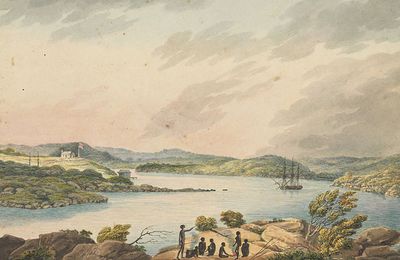←Back to Sunburnt Country

An extract from “Sunburnt Country”
In this extract from Sunburnt Country, Joëlle Gergis looks at how the First Fleet got a first taste of Australia’s unforgiving climate. Read the entire extract over at The Conversation.
The women screamed as the huge waves crashed loudly on the wooden deck. Horrified, they watched the foaming torrent wash away their blankets. Many dropped to their knees, praying for the violent rocking to stop. The sea raged around them as the wind whipped up into a frenzy, damaging all but one of the heavily loaded ships.
The severe storm was yet another taste of the ferocious weather that slammed the First Fleet as it made its way across the Southern Ocean in December 1787. Now, after an eight-month journey from England in a ship riddled with death and disease, the passengers’ introduction to Australia was also far from idyllic. The unforgiving weather that greeted the First Fleet was a sign of things to come. More than once, intense storms would threaten the arrival of the ships and bring the new colony close to collapse.
So how did the early arrivals to Australia deal with such extreme weather? Have we always had a volatile climate? To answer these questions, we need to follow Australia’s colonial settlers back beyond their graves and trace through centuries-old documents to uncover what the climate was like from the very beginning of European settlement. By poking around in the settlers’ old diaries, letters and newspaper clippings, we can begin to piece together an idea of what the country’s climate was like long before official weather measurements began.
When the British sailed into Australian waters, they had no idea of what awaited them. Eighteen years before the arrival of the First Fleet, Captain James Cook had barely spent a week in Botany Bay. He didn’t even stop in for a quick stickybeak at Port Jackson, the settlement site that eventually came to be known as Sydney Cove. HMS Endeavour had only briefly skirted past modern-day Sydney Harbour in May 1770, so the British knew next to nothing of the land, its climate or its people. Perhaps they expected that life would resemble their other colonial outposts like India, or an undeveloped version of England. With enough hard work, surely the land could be tamed to support their needs. But when the First Fleet sailed into Sydney Cove, they unknowingly entered an ancient landscape with an unforgiving climate.

Violent storms
Even before Governor Arthur Phillip set foot in Botany Bay, violent storms had battered the overcrowded ships of the First Fleet. During the final eight-week leg of the journey from Cape Town to Botany Bay, the ships had sailed into the westerly winds and tremendous swells of the Southern Ocean. Ferocious weather hit the First Fleet as it made its way through the roaring forties in November–December 1787. Although the strong westerlies were ideal for sailing, conditions on the ships were miserable. Lieutenant Philip Gidley King described the difficult circumstances on board HMS Supply: “strong gales … with a very heavy sea running which keeps this vessel almost constantly under water and renders the situation of everyone on board her, truly uncomfortable”. Unable to surface on deck in the rough seas, the convicts remained cold and wet in the cramped holds.
As Christmas approached, King noted the surprisingly chilly conditions off the southwestern coast of Western Australia: “The cold is in the extreme here as in England at this time of year, although it is the height of summer here.” Aboard HMS Sirius, Judge David Collins wrote about how the crew tried to celebrate in “mountains high” seas, to no avail. On New Year’s Day 1788, Arthur Bowes Smyth, a surgeon aboard the Lady Penrhyn, described how the sea poured into his cabin:
Just as we had dined, a most tremendous sea broke in at the weather scuttle of the great cabin and ran with a great stream all across the cabin, and as the door of my cabin happened not to be quite closed shut the water half filled it, the sheets and the blankets being all on a flow. The water ran from the quarterdeck nearly into the great cabin, and struck against the main and missen chains with such a force as at first alarmed us all greatly, but particularly me, as I believed [the] ship was drove in pieces. No sleep this night.
In a letter to his father, Sirius crew member Newton Fowell described the terrible weather that greeted the new year: “This year began with very bad tempestuous weather, it blew much harder than any wind we have had since our leaving England.” As the atrocious conditions continued, the First Fleet was forced to slow down to prevent the ships’ sails from tearing. Earlier in December 1787, the Prince of Wales had lost its topsail and a man washed overboard in what a sailor on the Scarborough described as “the heaviest sea as ever I saw”.









